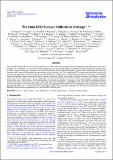Por favor, use este identificador para citar o enlazar a este item:
http://hdl.handle.net/10261/167615COMPARTIR / EXPORTAR:
 SHARE SHARE
 CORE
BASE CORE
BASE
|
|
| Visualizar otros formatos: MARC | Dublin Core | RDF | ORE | MODS | METS | DIDL | DATACITE | |

| Título: | The gaia -ESO survey: calibration strategy |
Autor: | Pancino, E.; Lardo, C.; Altavilla, G.; Marinoni, S.; Ragaini, S.; Cocozza, G.; Bellazzini, M.; Sabbi, E.; Zoccali, M.; Donati, P.; Heiter, Ulrike; Koposov, S.E.; Blomme, R.; Morel, T.; Símon-Díaz, S.; Lobel, A.; Soubiran, C.; Montalban, J.; Valentini, M.; Casey, A.R.; Blanco-Cuaresma, S.; Jofré, P.; Worley, C.C.; Magrini, L.; Hourihane, A.; François, P.; Feltzing, S.; Gilmore, Gerry; Randich, S.; Asplund, M.; Bonifacio, P.; Drew, J.E.; Jeffries, R.D.; Micela, Giusi; Vallenari, A.; Alfaro, Emilio J. CSIC ORCID CVN ; Allende Prieto, Carlos; Babusiaux, C.; Bensby, T.; Bragaglia, A.; Flaccomio, E.; Hambly, N.; Korn, A.J.; Lanzafame, A.C.; Smiljanic, R.; Van Eck, S.; Walton, N.A.; Bayo, A.; Carraro, G.; Costado, M. T. CSIC ORCID | Palabras clave: | Techniques: radial velocities Surveys Stars: abundances Techniques: spectroscopic Galaxy: general |
Fecha de publicación: | 2017 | Editor: | EDP Sciences | Citación: | Astronomy and Astrophysics 598: A5 (2017) | Resumen: | The Gaia-ESO survey (GES) is now in its fifth and last year of observations and has produced tens of thousands of high-quality spectra of stars in all Milky Way components. This paper presents the strategy behind the selection of astrophysical calibration targets, ensuring that all GES results on radial velocities, atmospheric parameters, and chemical abundance ratios will be both internally consistent and easily comparable with other literature results, especially from other large spectroscopic surveys and from Gaia. The calibration of GES is particularly delicate because of (i) the large space of parameters covered by its targets, ranging from dwarfs to giants, from O to M stars; these targets have a large wide of metallicities and also include fast rotators, emission line objects, and stars affected by veiling; (ii) the variety of observing setups, with different wavelength ranges and resolution; and (iii) the choice of analyzing the data with many different state-of-the-art methods, each stronger in a different region of the parameter space, which ensures a better understanding of systematic uncertainties. An overview of the GES calibration and homogenization strategy is also given, along with some examples of the usage and results of calibrators in GES iDR4, which is the fourth internal GES data release and will form the basis of the next GES public data release. The agreement between GES iDR4 recommended values and reference values for the calibrating objects are very satisfactory. The average offsets and spreads are generally compatible with the GES measurement errors, which in iDR4 data already meet the requirements set by the main GES scientific goals.© ESO, 2017. | URI: | http://hdl.handle.net/10261/167615 | DOI: | 10.1051/0004-6361/201629450 | Identificadores: | doi: 10.1051/0004-6361/201629450 issn: 1432-0746 |
| Aparece en las colecciones: | (IAA) Artículos |
Ficheros en este ítem:
| Fichero | Descripción | Tamaño | Formato | |
|---|---|---|---|---|
| IAA_2017_aa29450.pdf | 3,47 MB | Adobe PDF |  Visualizar/Abrir |
CORE Recommender
SCOPUSTM
Citations
51
checked on 18-abr-2024
WEB OF SCIENCETM
Citations
49
checked on 25-feb-2024
Page view(s)
285
checked on 19-abr-2024
Download(s)
78
checked on 19-abr-2024
Google ScholarTM
Check
Altmetric
Altmetric
NOTA: Los ítems de Digital.CSIC están protegidos por copyright, con todos los derechos reservados, a menos que se indique lo contrario.
